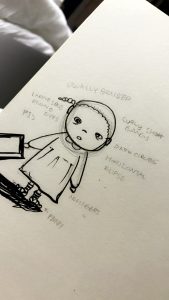Laetitia Sonami , Lady’s Glove, 1991 – now
Laetitia Sonami is a sound artist and a performer. One of her many projects that astounded me the most was the Lady’s Glove, first made in 1991. Made of rubber kitchen gloves and five Hall effect transducers glued at the tip of the fingers and a magnet on the right hand, varying voltages were fed to a Forth board and converted to MIDI signals. The signals controlled various synthesizers and samplers. Initially, the glove was a satirical response to the masculinity portrayed in virtual reality apparels. Ever since, she has created many iterations of the Lady’s Glove involving new technologies. In her third iteration of the Lady’s Glove, Sonami included a pressure pad with receivers located on her right arm and her left foot. The sensors allowed the program to translate Sonami’s entire bodily gestures into sound. After a few more iterations, the Lady’s Glove now consists of five microswitches, four Hall effect transducers, pressure pad, resistive strips, two ultrasonic receivers, and accelerometer that measures the speed of hand motion. The signals go into STEIM’s Sensorlab, and are encoded into MAX-MSP software. The algorithms involved in this project would be the systems being transferred into STEIM’s Sensorlab. Although I have always found sound design fascinating, Sonami’s gloves resonated with me the most because of the idea of contradicting a stereotyped material and transforming an instrument. I could only imagine how much the rubber glove would have empowered women back in the 90’s and turned the table of perception towards them. I also found the idea of changing motion into intricately layered sound astonishing.
![[OLD FALL 2018] 15-104 • Introduction to Computing for Creative Practice](../../../../wp-content/uploads/2020/08/stop-banner.png)
